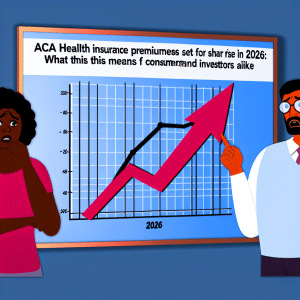The recent $4 trillion tax cut signed into law by President Trump, dubbed the “big beautiful bill,” has stirred a mix of relief and concern across the financial and healthcare landscapes. While the legislation extends several tax provisions, it notably leaves out an extension of the enhanced premium tax credits that have been a lifeline for millions of Americans purchasing health insurance through the Affordable Care Act (ACA) marketplace. This omission could have profound implications for investors, advisors, and the broader economy—an angle often overlooked in mainstream coverage.
Why the Enhanced Premium Tax Credits Matter More Than Ever
Since 2021, enhanced premium tax credits have dramatically lowered health insurance costs for ACA enrollees. According to the Kaiser Family Foundation (KFF), over 22 million Americans—about 92% of ACA marketplace enrollees—benefited from these subsidies in 2024. The average enrollee saved $705 this year, a 44% reduction in premium costs, as reported by the Center on Budget and Policy Priorities.
Without these enhanced credits, premiums are projected to surge by more than 75% in 2026. This spike is not just a number; it translates into real financial strain for millions of households, potentially pushing 4.2 million Americans into the uninsured category over the next decade, per the Congressional Budget Office. This is on top of nearly 12 million people expected to lose coverage due to over $1 trillion in healthcare spending cuts aimed at offsetting the tax cut’s cost.
The Investor Implications: A Healthcare Market at a Crossroads
For investors, the healthcare sector is entering a period of significant volatility and uncertainty. The rollback of federal healthcare support—the largest in history—signals a potential contraction in the ACA marketplace. This could lead to reduced enrollment and increased out-of-pocket costs, altering the demand dynamics for health insurers and related healthcare services.
Healthcare stocks tied to ACA marketplace performance may face headwinds, while companies focusing on alternative insurance models or direct-to-consumer health services might see new opportunities. Additionally, sectors like pharmaceuticals and medical devices could experience shifts as uninsured populations delay or forego treatment.
What Advisors and Investors Should Do Differently Now
-
Reassess Healthcare Exposure: Investors should scrutinize their portfolios for exposure to ACA-dependent insurers and consider diversifying into companies with broader, more resilient business models or those innovating in affordable care delivery.
-
Monitor Policy Developments Closely: Given the political volatility around healthcare funding, staying informed about legislative changes is crucial. Advisors should prepare clients for potential premium increases and insurance market shifts.
-
Focus on Health Equity Trends: The enhanced subsidies notably increased coverage among Black, Latino, lower-income households, self-employed workers, and small business owners. As these groups face disproportionate impacts from subsidy expirations, there may be emerging markets for tailored financial products and services addressing their unique needs.
-
Advocate for Client Education: Advisors must proactively educate clients about potential increases in health insurance costs and explore alternative coverage options, including Health Savings Accounts (HSAs) and supplemental insurance products.
What’s Next? Forecasting the Healthcare Landscape
The expiration of enhanced premium tax credits after 2025 sets the stage for a healthcare affordability crisis that could ripple through the economy. According to a recent Peterson Center on Healthcare report, ACA enrollment doubled from about 11 million in 2020 to nearly 24 million in 2025, largely due to these subsidies. A reversal could stall or reverse this progress, increasing uninsured rates and financial strain on households.
From an investment perspective, the next 12 to 24 months will be critical. Market participants should watch for:
- Legislative efforts to reinstate or modify subsidies.
- Insurer responses to premium hikes and enrollment changes.
- Innovation in affordable healthcare delivery models.
- Broader economic impacts from increased uninsured populations, including potential rises in uncompensated care costs that affect hospital systems and taxpayers.
Unique Insight: The Ripple Effect Beyond Healthcare
An often-overlooked impact is how rising healthcare premiums and uninsured rates could influence consumer spending patterns. Higher out-of-pocket costs may reduce disposable income, affecting retail, housing, and even transportation sectors. For example, a recent survey by the Urban Institute found that households facing increased healthcare costs often cut back on non-essential spending, which can dampen economic growth.
Final Takeaway for Extreme Investors
The omission of enhanced premium tax credits from the recent tax legislation is a red flag signaling turbulence ahead in healthcare markets and beyond. Investors and advisors who anticipate these changes and adjust strategies accordingly will be better positioned to navigate the coming shifts. Healthcare affordability is not just a policy issue—it’s a critical economic variable that demands attention from anyone serious about financial resilience and growth.
For those looking to stay ahead, now is the time to deepen your understanding of healthcare policy impacts, diversify your healthcare investments, and prepare clients for a landscape where healthcare costs could become a dominant financial stressor. The next wave of opportunity lies in innovation and adaptation—those who act early will reap the rewards.
Sources:
- Kaiser Family Foundation (KFF)
- Center on Budget and Policy Priorities
- Congressional Budget Office (CBO)
- Peterson Center on Healthcare
- Urban Institute
Stay tuned to Extreme Investor Network for exclusive insights that empower you to turn policy shifts into investment opportunities.
Source: Why ACA health insurance premiums may see ‘sharp’ increase in 2026

